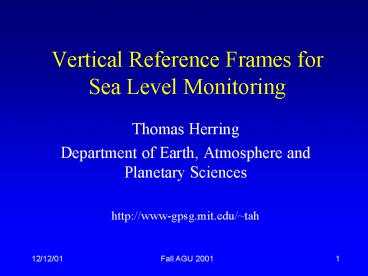Vertical Reference Frames for Sea Level Monitoring - PowerPoint PPT Presentation
Title:
Vertical Reference Frames for Sea Level Monitoring
Description:
Satellite phase center positions effects. 12/12/01. Fall AGU 2001. 9. Scale estimates ... Fall AGU 2001. 11. Effects of changes in the satellite phase center position ... – PowerPoint PPT presentation
Number of Views:21
Avg rating:3.0/5.0
Title: Vertical Reference Frames for Sea Level Monitoring
1
Vertical Reference Frames for Sea Level Monitoring
- Thomas Herring
- Department of Earth, Atmosphere and Planetary
Sciences - http//www-gpsg.mit.edu/tah
2
Overview
- Examine scale variations in global reference
(system scale directly effects heights) - Effects of satellite phase center positions
- Systematic variations in scale and position
3
Acknowledgements
- Scripps Orbit and Permanent Array Center (SOPAC)
for making available re-processed permanent GPS
array data. Available as full-covariance,
loosely-constrained solutions - Mike Heflin at JPL for reprocessed GIPSY
analyses. Time series of results.
4
Analysis from SOPAC reprocessed GPS data between
1992 and 2001
- GPS phase measurements at L1 and L2 from a global
distribution of station used - Analysis here is un-constrained
- All site positions estimated
- Atmospheric delay parameters estimated
- Real bias parameters for each satellite global,
integer values for regional site combinations
(lt500 km) - Orbital parameters for all satellites estimated
(1-day orbits, 2-revolutions) - 6 Integration constants
- 3 constant radiation parameters
- 6 once-per-revolution radiation parameters
5
Global GPS analysis
- Data used between 1992-2001
- Full analysis has 600 stations (analysis here
restricted to 100 sites that have more than 5
years of data - Large density of sites (300) in California
- Total data set has gt 2 billion phase measurements
6
Specific sites analyzed
- Total of 100 sites analyzed of which 50 were used
to realize coordinate system based on ITRF2000 - Since analysis has little constraint, it is
- Free to rotate
- Possibly free to translate (explicit estimation)
- Possibly free to change scale (explicit
estimation) - Latter two effects should not be present but
these we will explore here.
7
Network used in analysis
Black Frame sites Red other sites
8
Results from analysis
- Common Mode errors seen in regional frames
- Scale variations Comparison with ITRF-2000 and
recent JPL analysis (Mike Heflin) - Satellite phase center positions effects
9
Scale estimates
10
Estimated height rates as function of latitude
11
Effects of changes in the satellite phase center
position
As the position of the phase center changes, an
elevation angle dependent error is introduced. dh
is change in radial component
dr dh cos g sin g (R/a) sin y (R/a) 0.24
12
Height changes per unit offset as function of
minimum and maximum elevation angles used in data
analysis
Polar sites will have limited max
elevationTypical effect is 0.03 m/m
13
Summary of effects
- GAMIT scale rate -0.24 ppb/yr JPL scale rate
-0.10 ppb/yr - 51-GPS reference sites in ITRF2000 have average
height rate of 0.9 mm/yr (0.14 ppb/yr) - Satellite phase center Block II 1.023 m or 0.953
m? expected scale change 0.35 ppb
14
Conclusion
- Both GAMIT and JPL analyses show negative scale
rate. Height rates 1.5-0.6 mm/yr. - Common annual signals in time series are likely
to be real (atmospheric/snow loading effect).
ITRF may need non-secular components to site
positions to be better define the terrestrial
system. - Evolution of GPS constellation with time might
explain part of the scale change or Average
height rates in ITRF2000 may be biased.































